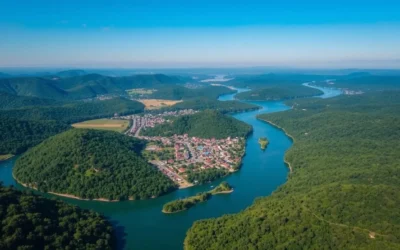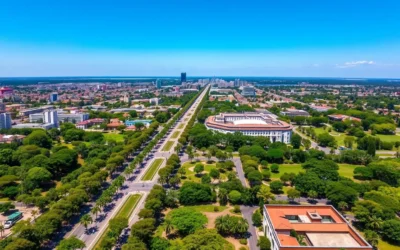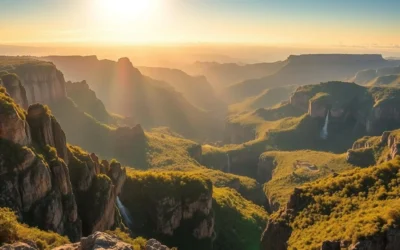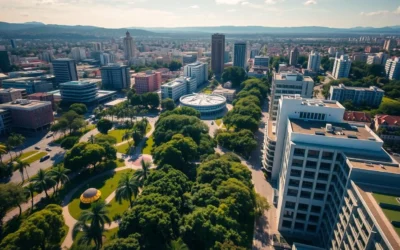The Amazon Rainforest produces a staggering 20% of the world’s oxygen while covering just 6% of Earth’s surface. This breathtaking ecosystem spans nine countries, but Brazil holds the lion’s share—a massive 60% of this natural wonder. Home to one in ten known species on our planet, the Brazilian Amazon offers travelers an unparalleled opportunity to experience nature at its most diverse and awe-inspiring.
From spotting pink river dolphins and sleeping in treetop lodges to cruising along the mighty Amazon River and meeting indigenous communities, this comprehensive guide covers everything you need to know to plan an unforgettable adventure in the world’s largest rainforest.
Getting There & Planning Your Journey
The Brazilian Amazon is vast, covering approximately 4 million km² (1.5 million mi²), so planning your entry point is crucial. The two main gateway cities are Manaus and Belém, with Manaus being the most popular starting point for most Amazon adventures.
Main Entry Points
- Manaus – The capital of Amazonas state and the largest city in the Amazon region
- Belém – The capital of Pará state, offering access to the eastern Amazon
- Santarém – A smaller city providing access to the beautiful Tapajós region
- Porto Velho – Gateway to the southern Amazon
Flying to the Amazon
International travelers typically fly into major Brazilian cities like São Paulo or Rio de Janeiro before connecting to Amazon gateway cities. Direct international flights to Manaus are available from Miami and Panama City.
Ready to Start Your Amazon Adventure?
Find the best flight deals to Manaus, Belém, or other Amazon gateway cities.
Visa Requirements
Many visitors, including those from the US, Canada, Australia, and EU countries, do not need a visa for stays up to 90 days. Always check the latest requirements before traveling as regulations can change.
Planning Timeline
For the best experience, plan your Amazon trip at least 3-6 months in advance, especially if visiting during high season (June to September). This ensures you’ll secure spots at the best lodges and tours, which often book up quickly.
Best Time to Visit & Weather Tips

The Amazon has two distinct seasons: the rainy season (December to May) and the dry season (June to November). Each offers unique experiences and considerations for travelers.
Best Time to Visit the Amazon Rainforest
| Season | Months | Pros | Cons |
| Dry Season (Recommended) | June to November | Less rainfall, more hiking opportunities, exposed river beaches, easier wildlife spotting on land | Higher temperatures, more crowded, some waterways may be inaccessible by boat |
| Rainy Season | December to May | Fewer tourists, lush vegetation, better for boat excursions, water levels 9-12m higher | Daily rainfall, some trails flooded, higher humidity, more mosquitoes |
| Transition Period | May-June & November-December | Balance between accessibility and crowds, moderate water levels | Unpredictable weather patterns |
Pro Tip: If you want to see the famous river beaches of Alter do Chão (the “Caribbean of the Amazon”), visit between August and January when water levels are lower and the white sand beaches are exposed.
Temperature & Climate
The Amazon maintains a consistently hot and humid climate year-round:
- Average temperatures: 27-30°C (80-86°F)
- Humidity: 80-90% throughout the year
- Annual rainfall: 2,000-3,000mm (79-118 inches)
Pack lightweight, breathable clothing regardless of when you visit, along with rain gear even during the dry season, as brief afternoon showers are common.
Getting Around Locally

The Amazon’s vast network of rivers serves as the region’s highways. Understanding your transportation options is essential for navigating this unique environment.
River Travel
Rivers are the lifeblood of the Amazon, and most travel within the region happens on water:
- Public ferries – Affordable but basic transportation between major river cities
- Private speedboats – Faster but more expensive option for shorter distances
- Tour boats – Comfortable vessels for guided excursions
- Luxury cruises – All-inclusive experiences with private cabins and guided excursions
The 31-hour ferry journey from Manaus to Santarém offers an authentic Amazon experience, though accommodations are basic (passengers typically sleep in hammocks).
Land Transportation
Within Amazon cities and towns:
- Taxis – Available in all major cities
- Rental cars – Useful in cities but limited for rainforest exploration
- Motorbike taxis – Common in smaller towns like Alter do Chão
Need Transportation in Amazon Cities?
Rent a car in Manaus, Belém, or other gateway cities for urban exploration.
Guided Tours
For exploring the rainforest itself, guided tours are essential. Most jungle lodges and cruises include transportation from gateway cities as part of their packages.
Where to Stay in the Amazon

Accommodation options in the Amazon range from rustic jungle lodges to luxury river cruises. Your choice will significantly impact your rainforest experience.
Jungle Lodges
Jungle lodges offer the most immersive Amazon experience, typically located in remote areas accessible only by boat. Most operate on all-inclusive packages that include transfers from gateway cities, meals, and guided excursions.
Budget Lodges
Simple accommodations with basic amenities, shared bathrooms, and guided excursions.
Price range: $80-150 per person/night
Example: Amazônia Exxperience
Mid-Range Lodges
Comfortable private bungalows, quality meals, and comprehensive excursion packages.
Price range: $150-300 per person/night
Example: Dolphin Lodge, Tahuayo Lodge
Luxury Lodges
Premium accommodations with amenities like swimming pools, air conditioning, and gourmet dining.
Price range: $300-600+ per person/night
Example: Juma Lodge, Anavilhanas Lodge
Amazon River Cruises
River cruises offer a different perspective, allowing you to cover more territory while enjoying comfortable accommodations. Options range from traditional wooden boats to luxury vessels with suite cabins.
- Expedition cruises – Focus on wildlife and exploration with expert guides
- Luxury cruises – Offer premium amenities like gourmet dining and spacious cabins
- Traditional riverboats – Authentic experience with more basic accommodations
City Accommodations
In gateway cities like Manaus and Belém, you’ll find standard hotel options ranging from budget to luxury:
- Manaus: Villa Amazonia, Hotel Tropical Manaus, Novotel Manaus
- Belém: Radisson Hotel Belém, Grand Mercure Belém, Hotel Regente
- Alter do Chão: Casa Saimiri, Villa Arumā Pousada
Find Your Perfect Amazon Stay
From jungle lodges to city hotels, book the ideal accommodation for your Amazon adventure.
Dining & Local Cuisine

Amazonian cuisine is a fascinating blend of indigenous traditions, Portuguese influences, and the unique ingredients of the rainforest. Exploring local food is an essential part of the Amazon experience.
Signature Amazon Dishes
- Pirarucu – One of the world’s largest freshwater fish, often served grilled or in stews
- Tambaqui – Popular fish with ribs that are grilled and served as “tambaqui de banda”
- Tacacá – Spicy soup made with jambu (a mouth-numbing herb), dried shrimp, and yellow tucupi sauce
- Maniçoba – Cassava leaf stew cooked for a week to remove toxins, similar to feijoada
- Açaí – Served as a savory side dish in the Amazon, not the sweet dessert found elsewhere
Exotic Fruits
The Amazon is home to countless exotic fruits you won’t find elsewhere:
- Cupuaçu – Relative of cacao with a unique tropical flavor
- Bacuri – Sweet-sour fruit with a custard-like texture
- Camu Camu – Small tart fruit with the highest natural vitamin C content
- Tucumã – Orange fruit often served in sandwiches for breakfast
Where to Eat
Your dining options will vary depending on your location:
In Major Cities
- Manaus: Banzeiro, Caxiri, Tambaqui de Banda
- Belém: Casa Iga, Restaurante Ver O Açaí, Amazônia na Cuia
At Jungle Lodges
Most lodges offer all-inclusive meal packages featuring local ingredients and traditional recipes. Meals are typically served buffet-style or as set menus.
Food Safety Tip: In remote areas, stick to bottled water and fully cooked foods to avoid stomach issues. Even in cities, it’s advisable to avoid tap water and raw vegetables unless you’re sure they’ve been properly prepared.
Attractions, Sightseeing & Activities

The Amazon offers countless activities and experiences that connect visitors with its extraordinary biodiversity and cultural heritage. Here are the absolute must-do activities for any Amazon adventure.
Wildlife Encounters
- Pink Dolphin Watching – Observe these unique freshwater mammals in their natural habitat
- Bird Watching – Spot colorful macaws, toucans, and hundreds of other species
- Night Safaris – Search for nocturnal creatures like caimans, tarantulas, and tree frogs
- Monkey Spotting – Look for various species including squirrel monkeys, howler monkeys, and the tiny pygmy marmoset
Rainforest Exploration
- Jungle Trekking – Guided walks through primary rainforest to learn about flora and fauna
- Canopy Tours – Experience the rainforest from above via observation towers or walkways
- Survival Training – Learn basic jungle survival skills from experienced guides

Water Activities
- River Cruises – From luxury multi-day journeys to short excursions
- Canoe/Kayak Expeditions – Paddle through flooded forests and narrow tributaries
- Fishing for Piranha – Try your hand at catching these famous fish (catch and release options available)
- Swimming – Cool off in designated safe areas of blackwater rivers
Natural Phenomena
- Meeting of the Waters – Where the dark Rio Negro meets the sandy-colored Solimões River and runs side by side without mixing for 6km
- Giant Water Lilies – See the Victoria amazonica with leaves up to 3m in diameter
- Clay Licks – Watch hundreds of colorful macaws gather at riverside clay deposits
Ready for Unforgettable Amazon Experiences?
Book guided tours and activities with experienced local operators.
Museums, Cultural Spots & Festivals

Beyond its natural wonders, the Amazon region offers rich cultural experiences that showcase its fascinating history and diverse heritage.
Must-Visit Cultural Sites
- Teatro Amazonas (Manaus) – Opulent opera house built during the rubber boom, symbolizing the region’s historic wealth
- Museu do Índio (Manaus) – Showcases indigenous cultures of the Amazon
- Mercado Ver-o-Peso (Belém) – Massive riverside market dating from 1688, offering a glimpse of local life
- Museu Emílio Goeldi (Belém) – Natural history museum with extensive Amazonian collections
- Encontro das Águas Museum Park (Manaus) – Cultural center near the Meeting of Waters
Indigenous Communities
Visiting indigenous communities can be a profound cultural experience, but must be done respectfully and through established channels:
- Many jungle lodges offer visits to partner communities
- Learn about traditional knowledge, crafts, and sustainable forest use
- Purchase authentic handicrafts directly from artisans
Important: Only visit indigenous communities through reputable tour operators who have established relationships with these communities and ensure visits are conducted ethically with proper permissions.
Amazon Festivals
Experience local culture through these vibrant celebrations:
- Boi Bumbá (Parintins) – Massive folklore festival held annually in June
- Círio de Nazaré (Belém) – One of Brazil’s largest religious processions in October
- Festival de Ópera do Amazonas (Manaus) – Annual opera festival at the Teatro Amazonas
- Sairé Festival (Alter do Chão) – Traditional celebration blending indigenous and Catholic traditions in September

Sports, Nature & Outdoor Experiences

The Amazon offers countless opportunities for outdoor enthusiasts to connect with nature through active experiences.
Adventure Activities
- Canopy Ziplines – Soar through the treetops on zipline systems
- Canopy Climbing – Scale tall rainforest trees with professional equipment
- Jungle Camping – Spend a night under the stars in the rainforest
- Mountain Biking – Explore jungle trails on two wheels (available near some lodges)
- Stand-Up Paddleboarding – Navigate calm waterways on a paddleboard
Nature Immersion
- Birdwatching – The Amazon is home to over 1,500 bird species
- Botanical Exploration – Learn about medicinal plants and rainforest ecology
- Wildlife Photography – Capture the Amazon’s incredible biodiversity
- Stargazing – Experience the night sky free from light pollution

Beach Experiences
During the dry season (August-January), river beaches emerge, offering unique experiences:
- Alter do Chão – Known as the “Caribbean of the Amazon” for its white sand beaches
- Ilha do Amor (Love Island) – Beautiful beach accessible by short boat ride
- Ponta Negra (Manaus) – Urban beach along the Rio Negro
Sustainable Tourism Activities
- Reforestation Projects – Some lodges offer tree-planting activities
- Scientific Tourism – Join researchers studying rainforest ecology
- Community-Based Tourism – Support local initiatives that benefit communities
Experience the Amazon’s Natural Wonders
Book guided outdoor adventures with expert naturalists.
Safety, Etiquette & Local Customs

While the Amazon is generally safe for tourists, understanding key safety considerations and cultural norms will enhance your experience.
Health & Safety
- Vaccinations – Yellow fever vaccination is recommended (not required). Consider hepatitis A and typhoid as well.
- Malaria Prevention – Consult your doctor about antimalarial medication and use insect repellent containing DEET.
- Mosquito Protection – Wear long sleeves and pants, especially during dawn and dusk.
- Water Safety – Drink only bottled or purified water and avoid ice in remote areas.
- Wildlife Safety – Never approach or feed wild animals, and always follow guide instructions.
Important: Always travel with comprehensive travel insurance that covers emergency evacuation, as medical facilities in remote areas may be limited.
Cultural Etiquette
Respecting local customs is essential when visiting the Amazon:
- Ask permission before photographing local people
- Dress modestly when visiting communities (cover shoulders and knees)
- Learn a few basic Portuguese phrases
- Follow all guidelines when visiting indigenous territories
- Support local businesses and artisans
Environmental Responsibility
- Choose eco-certified lodges and tour operators
- Never purchase products made from endangered species
- Minimize plastic use and pack out all trash
- Stay on designated trails to avoid damaging vegetation
- Respect wildlife by maintaining appropriate distances

Practical Travel Tips

These practical tips will help you prepare for a smooth and enjoyable Amazon experience.
Essential Packing List
Clothing
- Lightweight, quick-dry long pants and shirts
- Rain jacket or poncho
- Sturdy hiking shoes or boots
- Sandals or water shoes
- Hat with brim for sun protection
- Swimwear
- Light sleepwear
Equipment
- Insect repellent with DEET
- Sunscreen (reef-safe preferred)
- Binoculars for wildlife viewing
- Headlamp or flashlight
- Reusable water bottle
- Dry bag for electronics
- Basic first aid kit
Communication & Connectivity
- Cell service is limited or non-existent in remote areas
- Most lodges have limited or no Wi-Fi
- Consider downloading offline maps and translation apps
- Inform family/friends of your itinerary before departing
Money Matters
- Brazilian currency is the Real (R$)
- ATMs are available in cities but not in remote areas
- Bring enough cash for tips and small purchases
- Many lodges accept credit cards but have a backup payment method
- Tipping guides (10-15%) and lodge staff is customary
Language
Portuguese is Brazil’s official language. While English is spoken at most tourist facilities, learning a few basic phrases will enhance your experience:
- Olá – Hello
- Obrigado/Obrigada – Thank you (male/female)
- Por favor – Please
- Bom dia/Boa tarde/Boa noite – Good morning/afternoon/night
Pro Tip: Pack a portable battery pack/power bank as electricity may be limited to certain hours at some remote lodges.
Recommended Itineraries

Whether you have a few days or two weeks, these sample itineraries will help you make the most of your Amazon adventure.
3-Day Amazon Highlights (Short Trip)
Perfect for travelers with limited time who want to experience the essentials:
- Day 1: Arrive in Manaus, visit Teatro Amazonas and local markets
- Day 2: Full-day tour to the Meeting of Waters and jungle introduction
- Day 3: Half-day canoe trip through flooded forests, return to Manaus
5-7 Day Amazon Immersion (Recommended)
The ideal length for a more complete Amazon experience:
- Day 1: Arrive in Manaus, city tour
- Days 2-5/6: Transfer to jungle lodge for daily excursions (wildlife spotting, jungle walks, canoe trips, night safaris)
- Day 6/7: Return to Manaus for departure
10-14 Day Amazon Adventure (Comprehensive)
For those seeking a deeper exploration of the region:
- Days 1-2: Manaus exploration
- Days 3-6: Jungle lodge stay near Manaus
- Days 7-8: Amazon River ferry to Santarém
- Days 9-12: Alter do Chão for river beaches and Tapajós National Forest
- Days 13-14: Belém for urban Amazon culture and cuisine
Create Your Perfect Amazon Adventure
Book accommodations, tours, and transportation for your ideal itinerary.
Experience the Wonder of the Amazon

The Brazilian Amazon offers an unparalleled journey into one of Earth’s most extraordinary ecosystems. From the thrill of spotting elusive wildlife to the wonder of sleeping surrounded by a symphony of jungle sounds, an Amazon adventure creates memories that will last a lifetime.
As you plan your trip, remember that the rainforest moves at its own pace. Embrace the unexpected, be patient with wildlife sightings, and allow yourself to fully immerse in the natural rhythms of this remarkable environment. The Amazon rewards those who approach it with respect, curiosity, and a sense of wonder.
Whether you’re paddling silently through flooded forests at dawn, watching scarlet macaws gather at a clay lick, or learning about medicinal plants from a local guide, the Amazon offers experiences that connect us to the wild heart of our planet. In an increasingly developed world, these pristine places become ever more precious—both to visit and to protect.
Start planning your Amazon adventure today, and discover why this magnificent rainforest continues to captivate explorers, scientists, and travelers from around the world.
The above is subject to change.
Check back often to TRAVEL.COM for the latest travel tips and deals.






